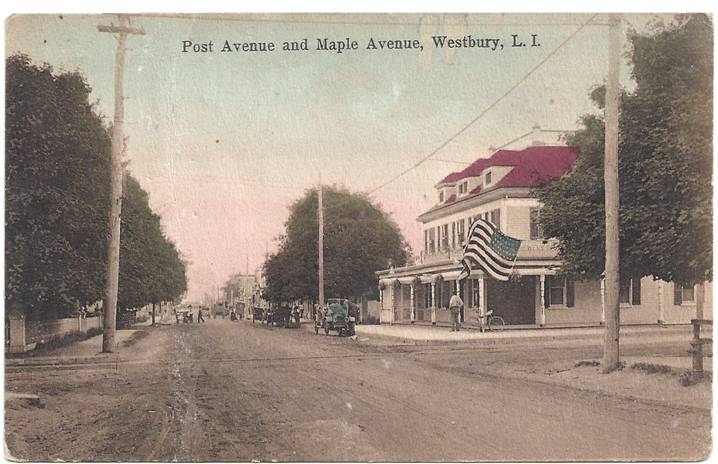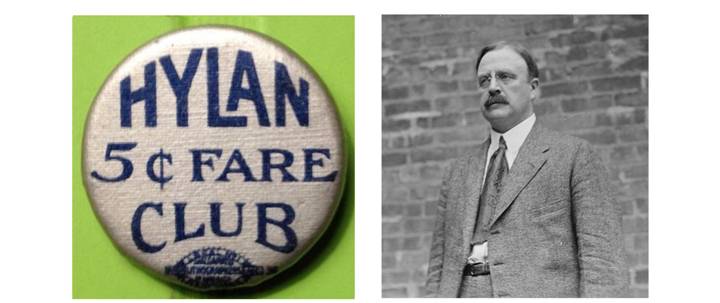Success and Decline

collection of Mark Thomas, HHS Class of 1975; used with permission
As expected, towns took pride in the trolley line. This nicely tinted postcard features Westbury's States Hotel. The photographer framed the shot so as to show the tracks crossing Post Avenue. A similar contemporary postcard shows a trolley on the same tracks. The flag helps narrow the date - the 46-star American flag was in use only until 1912.
A breezy summer ride with open windows felt good to workers returning from a hot day on the job, or to mothers caring for their tots. An autumn weekend trolley foray with one's club was a pleasant way to try something new. People quite enjoyed the new trolley line. Very few complaints were registered, the main one being about rowdy young locals who rode the late night trolley for a while, mocking and insulting fellow passengers.
There soon were rumors that the line was so successful that it would be extended, at first only to Farmingdale, and after that... well, who could tell?
Revenue, Expense
Such was the perception in Hicksville. In Roslyn, the outlook was less bright. After about four years, George Stanley concluded that the line might never become profitable. There were happy patrons, but contrary to his (and his investors') expectations, property values along the new branch had not risen dramatically. The village population was steadily inching upward, but it would not double for some time.

1910 view of NY&NS trestle at Mineola from Seyfried, NY & NS Traction Company
The start-up delays had deprived the NY&NS of months of revenue. The steel Mineola trestle and bridge were built not only upon their foundations, but also upon the dollars that had been spent on legal fees and "secret" real estate acquisitions. To make matters worse, the line's ongoing operating expenses were greater than planned.
Flooding was a cause for concern. The unpaved public roads which the NY&NS followed had never been graded for drainage. In the horse-and-buggy era, when roads near the bays on the North Shore, and near Cushing's Pond (a hollow just north of Mineola ), flooded, people found detours. Trolleys could improvise no detours; the tracks and wire were only where they were. Every year, floods isolated parts of the line for days at a time, shutting off service and revenue.
The price of coal - needed for the NY&NS generating station in Roslyn - was a growing and serious problem. In the first ten years of operation, the wholesale price of coal quadrupled. In 1920-1921, it spiked to ten times the 1908 price. The increased cost of generating electricity could easily force the company into insolvency.
Fare and Unfare
For a while, it appeared that the line might become sustainable if ridership increased soon enough, but to guarantee success, the NY&NS would need a fare increase.
The 5¢ fare - set according to 1908's economic forecasts, which did not anticipate war-related inflation - was regulated by the State's Public Service Commission. For reasons noted above, as the 1910s wore on, fares barely covered operating expenses. Employees were overdue for a raise; when it happened, fares would no longer offset costs. The need for an increase was dire.
Approval for an increase seemed a remote possibility - until NYC Mayor John Francis Hylan joined the fray, and it became completely impossible.

worthpoint.com photo - Library of Congress photo
John Hylan was born to poverty. As a teen, he left the Catskills for Brooklyn (then the second largest city in the country, after New York). He worked on the elevated railway tracks, and slowly advanced to a position as train engineer. In his off-hours, he studied diligently, eventually getting a law degree.
As a trial lawyer, he became acquainted with many judges, which led to his joining the Democratic Party soon after Brooklyn amalgamated with New York City. For years, the efforts of Manhattan-based Tammany Hall failed to establish a good relationship with Brooklyn's Democrats. In 1917, when Hylan's judicial connections proposed him as a mayoral candidate, the idea was accepted as a way to help unite the Democrats of Brooklyn and Tammany. With the Democrats' opposition votes split among three parties, he was elected Mayor.
His peers later recalled Hylan as possessing an unimaginative, child-like mind, and a simple agenda: punishing private transit "interests," especially by constraining them to 5¢ fares. His connections to Albany induced the Public Service Commission to follow his lead.
Disasters, Donations, Demise
Over the final years of service (1917-1921), the NY&NS repeatedly verged on bankruptcy, and there were numerous stoppages of service. The line struggled to survive. Snow and ice became worse problems than floods.
Most of the trolley line ran on public roads, and before automobiles became common, roads were not plowed. Horses could not push plows through snow; instead, they were hitched to sleighs and traveled atop it. Coincidentally, the 1910s sent more big winter storms across Long Island than usual. The photo of the snowbound LIRR train (below, left) was taken in Mineola in April 1915; there was a parade of many other trains stranded behind this one.

(left) Joseph Burt photograph - (right) Snow Sweeper from Seyfried, NY & NS Traction Company
If the railroad could not defeat the storms, how could the NY&NS? It had begun with only one weapon to wield against snow, a rather genteel sweeper (above, right). Realizing that sweepers could not remove the heavy snows that often occur near Atlantic shores, the company purchased a used "push" plow from an upstate railroad. It cannibalized one of its trolleys, and used the parts to devise a powered plow that would operate on the trolley line. The makeshift plow remained on the company's roster until the end of the NY&NS.
Even with its plow, the NY&NS had to shut down during big storms, losing revenue. And again and again, it had to pay laborers to shovel miles of the same tracks into operating shape.
Despite the line's problems and disruptions, the public generally remained loyal. For example, Henry Kuhl, a farmer at Hicksville's boundary with New Cassel, donated land along John Street for the erection of a shelter at the local trolley stop. The trolley line was already under duress, but it was willing to install electrical lighting in the shelter for the benefit of its riders.
The riders wanted to keep the trolleys going. At one point, knowing the line was in trouble, and had been denied a 7¢ fare, some riders started an early precursor to Go Fund Me. When they paid their fares, they voluntarily added two pennies to it. Paying 7¢ soon spread throughout the line. Because the practice had reached Queens, Mayor Hylan was able to bring charges against the NY&NS, which by State law was forbidden to collect more than the approved fare. The company then had to refuse riders' donations.
Eventually, Public Service Commission, still reluctant to raise the basic fare, did permit a restructuring of the fare zones. The result was that long-distance riders now paid more zoned 5¢ fares than they had before, and revenues increased slightly. In this way, the NY&NS was able to obtain more credit and survive a little longer.
The Stanleys tried to sell the line to Belmont's IRT. Acquiring it might have made some sense once the IRT reached Flushing, from which some of its riders might want trolley connections, but that day was years in the future. Although the price was fair, Mayor Hylan also declined the chance to purchase the line for NYC.
Instead, Hylan made a clumsy effort to force the NY&NS out of business. He issued statements about the Stanleys' supposed greed and mismanagement, and he announced that the City was starting to provide bus service over approximately the same routes in Queens. With that announcement, the trolley line's credit was cut off, as it appeared to have no future. Much to everyone's surprise, the Public Service Commission came to the rescue. At that time, NYC had no legal authority to operate a bus franchise, its vehicles and drivers did not meet State standards, and the bus line carried no insurance. New York State shut down the buses, and once again the trolley line could get the credit it needed to operate.
It limped along for a while. Once, it shut down because it could not afford coal for its power plant. Weathering the endless crises steadily grew harder, and finally, impossible. On May 1, 1921, the NY&NS announced that the following day would be the trolleys' last day of service - and it was.

